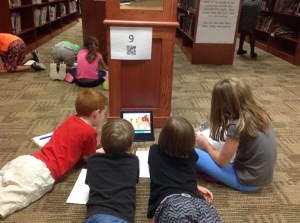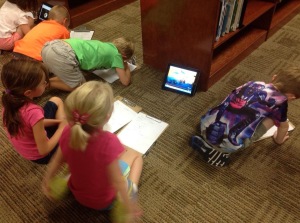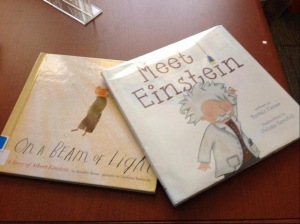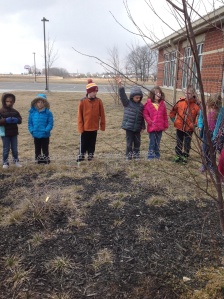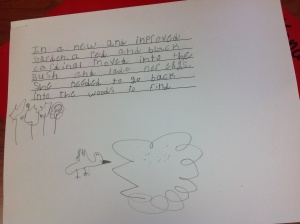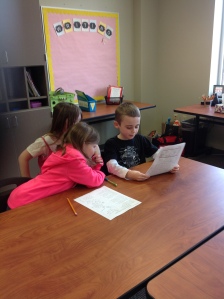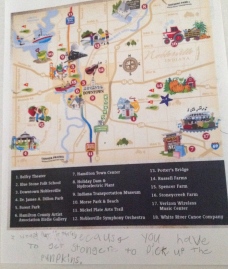A detailed first grade PBL built around curiosity and asking questions. Author: Audrey Lash, First Grade Teacher.
Entry Event: Armed with a clipboard, a question organizer, an iPad, and a pencil. Students went on a “surprise” field trip to our media center. Directions were (in small groups) go to each QR code and uncover the learning video behind it. Then, ask as many questions as you can! What child doesn’t like a little bit of mystery and asking all the questions he or she wants?
It’s the age-old “problem-based” story. Teachers teach a set curriculum. Students are often bored or are way more engaged in subjects of their own interests. After the entry event we posed this story to our students and asked the driving question, “How can we let our curiosity guide our learning?” Coming off the high of the entry event, students said,
- We KNOW: We like learning about stuff we WANT to learn. We like doing EXPERIMENTS and getting dirty. We like OPTIONS. We might work TOGETHER on a big project. We might form LEARNING CLUBS. If we’re bored, we’re not learning.
- We WONDER:What is curiosity?Is curiosity a fancy word for learning? How does curiosity guide our learning? Is curiosity a part of our schema? What does curiosity make us learn? What does being curious have to do with learning? Do we have to research?
Our first graders latched onto that learning club idea. As teachers, we latched on to the idea that learning and curiosity go hand-in-hand. We must make that learning like a surprise gift. One that they can’t wait to open.
Our next step: BUILD excitement around being curious. 4 items were gift wrapped in little bags for each table group: wooden-capital Q’s with question words, post-its, new fancy pens, and a glow in the dark ring. Each item to help us investigate that fancy word “curiosity” from our needs-to-knows and to prompt more questioning like our entry event. Our first graders quickly and CURIOUSLY tore into their gift bags. Finding they must use the question words to write tons of questions on post-its – allowing their curiosity to “shine” through. We had a whole wonder wall in less than 10 minutes; plus all the questions we asked in our entry event.
Over the next few days, we read mentor texts like Meet Einstein (by Mariela Kleiner) and On a Beam of Light (by Jennifer Berne). We capitalized on Albert Einstein as our guru of asking questions on all subjects. We channeled his spirit and asked more curious questions. Then, the hard work began. We sorted our questions based on (thick) hamburger questions and (thin) grilled cheese questions. Curiosity brings us all kinds of wonder, but we were looking for the juiciest kind. From all the hamburger questions, we found patterns and categorized them by topic. Topics like earth, water, humans, plants, animals, technology, and babies arose.
“AHA! This is where we can form those learning clubs.” We based learning clubs around topics we were most curious about. 6 groups formed and they sifted through “hamburger” questions on their topic and narrowed their curiosity to one key topic question.
- Curious questions in my class were: Why do babies have to drink milk? How do we have smart phones? Why do plants need leaves? Why does the sky turn different colors? How can we have super powers or be “super”? Why do elephants take mud baths?
We tested our team’s beginning collaboration with another gift wrapped surprise. Learning clubs were surprised with the task of putting a puzzle together. This showed teachers and groups how well we’d work together and what challenges we might face ahead. We signed team contracts and charted what a learning club should look like, sound like, and feel like. Learning clubs were in went through independent and guided research during literacy tasks. Many check-ins had to do with “I found these answers, now what? What do I understand now?” We jigsawed with other learning clubs to learn and ask clarifying questions of their understandings. We diagramed understanding and talked to experts. Learning clubs also partnered up to venn-diagram how their curious questions and understandings were similar. The next step in the process was for each learning club to design an experiment or observational hunt based on their understandings. (A great mentor text: 11 Experiments that Failed by Jenny Offill).
- My students designed experiments like: Observe one plant with leaves and one without. / Use mud on our own skin and see what happens. / Shine a flashlight (acting as the sun) through a piece of glass (acting as the atmosphere) to see if the light scatters. / Observe the ingredients on different types of milks. / Tinker and observe old and new phones.
So much learning and excitement because students had a VOICE in what they were learning. And, this is where we are. Next steps? Keep experimenting, keep showing our understandings in a variety of ways. The other day, there was murmur of students saying, “I wish we could ask others our question to see if they know what we know.” The students are leading the way. Listening to this one conversation shows us they’re ready for an authentic audience… perhaps even a “learning showcase” of sorts.
This Curiosity PBL is quite like a Genius Hour or an introduction to what inquiry is for first graders. Our main transfer for students was for them to learn to independently let their curiosity guide them to learning. No more asking a question and just getting an answer from an adult. Now, they have strategies for finding answers on their own.
